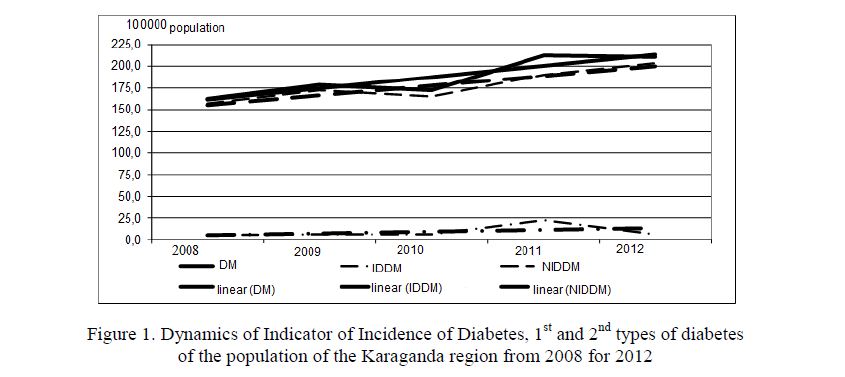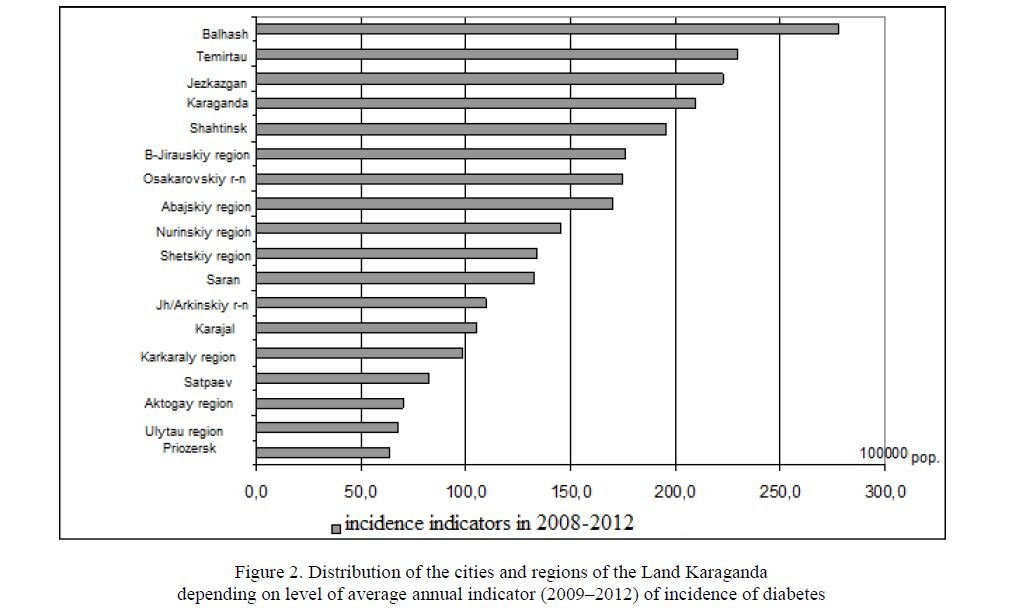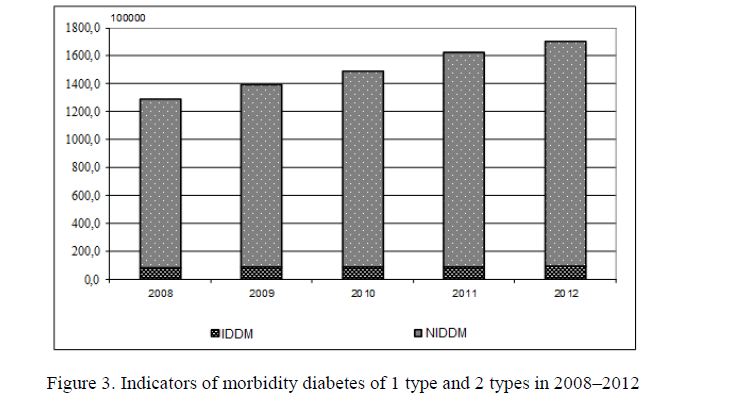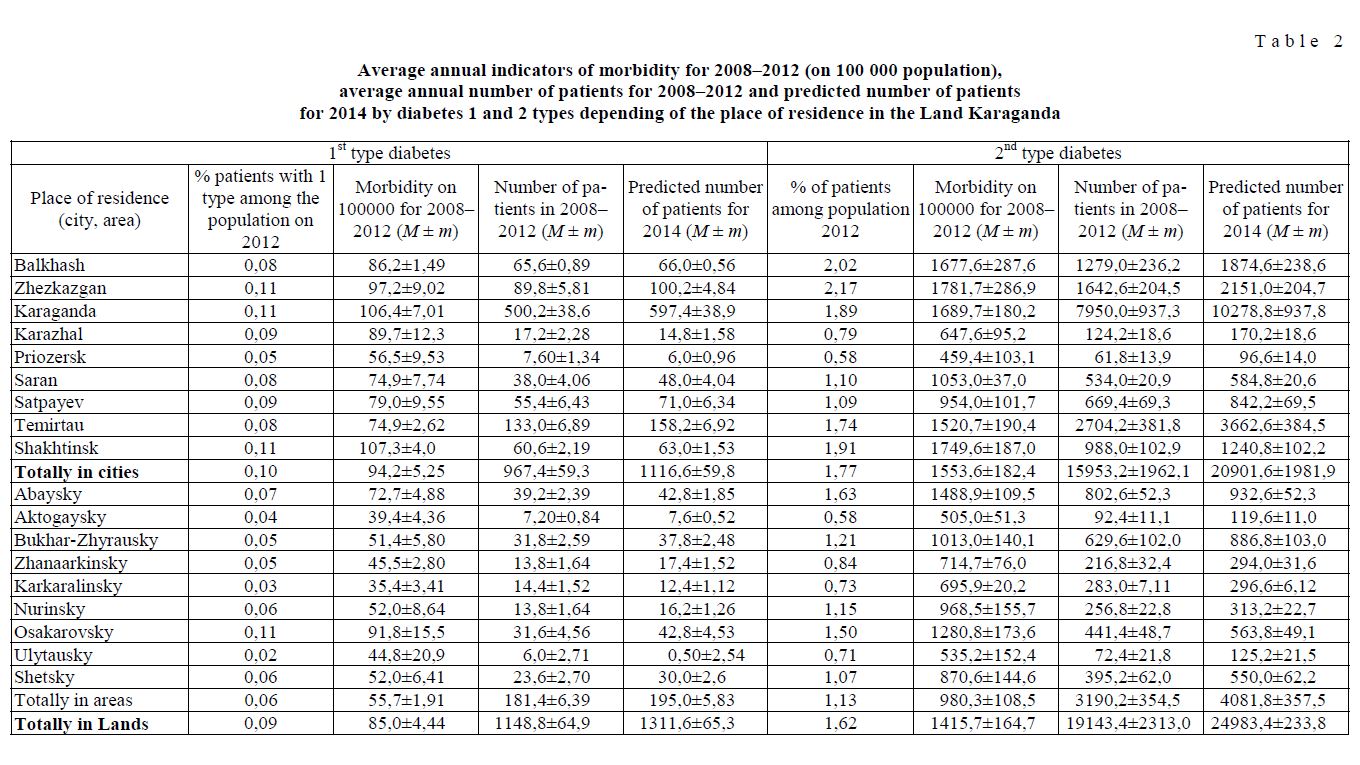On the basis of statistical analysis of dynamics indicators of incidence, morbidity by diabetes among population of the Land Karaganda from 2008 for 2012 was investigated. The average annual indicator of incidence of diabetes in area is 187,2 ± 19,4 on 100 000 population, morbidity — 1500,7 ± 169,2 on 100 000 population. There are tendency for increasing numbers of incidences of diabetes as of 1 and 2 types. Indicators of diabetes incidence and morbidity were authentically more higher among urban population comparatively with country people especially is more high in compared with in compared with territory of absolute prevalence of Kazakh population.
Relevance of diabetes is caused by metabolic changes, a high risk of development of atherosclerosis, vascular disorders, mental disorders, a frequent invalidism of patients, including children, teenagers, decrease in quality of life [1–6]. The Diabetes (D) is included into group of the diseases, including also cardiovascular diseases, malignant new growths, a chronic obstructive illness of lungs which is at the bottom of about 80 % of all cases of death from noninfectious diseases. According to WHO forecasts, in 2030 diabetes becomes the seventh cause of death on the importance [6, 7].
Actuality is determined by possibility of prevention developing of type 2 diabetes, making 80 % of all patients with diabetes, in patients with prediabetes. In Kazakhstan is organized some activity for early identification and prevention of development of diabetes: routine medical examinations of target groups of the population for the purpose of identification of socially significant diseases, including diabetes, at early stages, are carried out within the guaranteed volume of free medical care (order of Minister of Health of Kazakhstan dated November 10, 2009 No. 685 «About the approval of Rules of carrying out routine medical examinations of target groups of the population»). Considering that consequences of diabetes suffer an irreplaceable loss to the state, for the purpose of decrease in an incidence by diabetes, reduction of number of complications, increases in average life expectancy of patients of diabetes in Kazakhstan is allocated in the category of socially significant diseases demanding system decisions and measures of the state reaction. Thus, studying in developing of indicators of an epidemiological situation not only gives valuable information on a condition of a problem, but also is a basis for rational planning of the actions directed on improvement of results and quality of treatment of diabetes.
Now the territorial system of Kazakhstan include 14 Lands among which the Land Karaganda is the largest in KZ with more than 8 % of all population of the Kazakhstan.
Aim of work: to study main statistics data regarding diabetes in the Karaganda region, studying of incidence and morbidity of diabetes among the population of the Karaganda region from 2008 until 2012 were a research objective.
Material and research methods
Data of annual forms No.12 in 5 years (2008–2012) containing data of number of patients with for the first time established diagnosis of diabetes and patients, consisting on the account depending on diabetes type were a material for research. Forms of account included the patients living in 9 cities and 9 rural regions of area. Data on average annual population are submitted by Department of statistics of the Karaganda region. Statistical processing was carried out with Excell 10.0 program use.
Intensive indicators of incidence, morbidity on 100 000 population were calculated for the studied period, the average annual rate of increasing, check of a temporary row on a trend using of criterion of Coke and Stewart. Reliability was estimated by means of coefficient of Dickson and Mud. In the analysis of indicators recommendations L.Sachs [8] were considered.
Results
Results showed that indicators of incidence of diabetes in area from 2008 for 2012 increased by 22,3 %, growth of incidence by diabetes of 1 and 2 types — for 20,6 % and 25,6 % respectively (Fig. 1) was thus noted. Trends of incidence of diabetes of 1 and 2 types had increasing character (p<0,03). In structure for the first time the revealed patients with diabetes SD 2 types which specific weight averaged 95,1±3,15 % prevailed.

Figure 1. Dynamics of Indicator of Incidence of Diabetes, 1st and 2nd types of diabetes of the population of the Karaganda region from 2008 for 2012
The number of revealed new patients with other forms of diabetes was for the first time small and hesitated from 0 to 4 patients per year (only 9 patients for 5 years were revealed). In group of other specific forms of diabetes there were mainly patients with diseases of the exocrine tissue of pancreas and of gestational diabetes.
Results of studying of epidemioliogy showed growth of number of incidence of diabetes as in city was noted, and villages (Table 1). Thus, incidence of urban population in 2012 increased by 25,5 % in comparison with an indicator of 2008, among country people — for 10,4 %. Due to faster rate of a gain of incidence among residents in 2012 the indicator of incidence of diabetes of the persons living in the city exceeded a similar indicator of rural areas for 27,4 %, while in 2008 — for 12,7 % (p<0,01). The comparative analysis of an incidence of 1 type and 2 types showed (Table 1) that incidence indicators during the whole period were authentically higher among the persons living in the city in comparison with country people: 1 type — for 61,8 %, 2 type — for 29 %.
Now the Land Karaganda includes 9 rural areas: 1) Aktogaysky with the center in the village Aktogay;
2) Abaysky with the center in the city of Abay; 3) Bukhar-Zhyrausky with the center in Botakara settlement;
4) Karkaralinsky with the center in the city of Karkaralinsk, 5) Nurinsky with the center in Kievka settlement; 6) Osakarovsky with the center in Osakarovka settlement; 7) Zhanaarkinsky with the center in Atasu settlement; 8) Ulytausky with the center in Ulytau village, 9) Shetsky with the center in Aksu-Ayuli village and also 9 cities of regional submission. Biggest of them — the regional center the city of Karaganda. The second — Temirtau then followed Zhezkazgan, Balkhash, Shakhtinsk, Satpayev, Saran, Abay, Priozersk.
The comparative analysis of incidence in the certain cities and regions of area showed existence of essential distinctions on certain territories. Fluctuations of average annual indicators of incidence of diabetes last 5 years within 63,8 on 100000 population in the city of Priozersk to 277,6,0 on 100000 population in the city of Balkhash (Fig. 2). Distribution of areas depending on an incidence of diabetes showed that in 4 cities (Karaganda, Temirtau, Zhezkazgan and Balkhash) is noted rather high incidence (higher than 197,0 on 100000 population), middle — in the city of Shakhtinsk and in Bukhar-Zhyrausky area — average, and in 4 cities and 8 regions of area the average annual indicator of incidence of diabetes made less than 177,5 for 100 thousand population.
Indicators incidence of diabetes among urban and country people of the Karaganda region in 2008–2012 years
T a b l e 1


Figure 2. Distribution of the cities and regions of the Land Karaganda depending on level of average annual indicator (2009–2012) of incidence of diabetes
It is known that formation of epidemiological indicators is difficult process and these indicators formed in conditions of influence of various endogenous factors and factors of environment [9]. In view of multiplefactor nature of formation of epidemiological indicators, is of interest that in 64,3 % of regions with a low incidence of diabetes there were no specialists endocrinologists.
Studying of the contingent of patients with diabetes registered in Diabetes Re gistre showed that the number of patients with diabetes in area increased from 1,29 % in 2008 to 1,71 % in 2012, thus accumulation of patients with diabetes first of all determined by growth number of patients with diabetes 2 types (Fig. 3). Number of registered patients with 2 types in 2008 in Land Karaganda was increased from 93,9 % in 2008 until 94,7 % in 2012. In Karazhal, Priozersk, Aktogaysky, Bukhar-Zhirausky, Jean-Arkinsky, Nurinsky areas for 2–3 years, and in the Ulytausky area throughout all analyzed period it isn't registered any case of diabetes of 1 type.

Figure 3. Indicators of morbidity diabetes of 1 type and 2 types in 2008–2012
Thus, this is negative tendence for increasing number of new patients with type 1 diabetes in Ulytausky, and Bukhar-Zhirausky areas as in the cities Priozersk, Karazhal, and positive tendence — in Zhezkazgan, Karaganda, Temirtau, Saran, Satpayev, Shakhtinsk, Abaysky, Osakarovsky and Shetsky areas. In the contrary other tendence developing of dynamics indicator of morbidity of 2 type diabetes: in all cities and regions of area during period 2008–2012 years we observe increasing number of patients, varying from 6,0 % in the Karkaralinsky area to 46,9 % in the Nurinsky area is observed.
It is obviously that indicators of morbidity are reliable more high among urban population comparatively with population of rural areas. The comparative analysis of indicators of morbidity between the various cities and areas showed existence of essential distinctions not only between the population of city and rural areas, but also between the certain cities and regions of area (Table 2). Among cities of the Land Karaganda region the highest rate of morbidity diabetes both 1, and 2 types is noted in Karaganda, Zhezkazgan and Shakhtinsk, the lowest — in Priozersk. Among areas more high morbidity is in Abaysky and Osakarovsky area, the lowest indicators of morbidity are noted in Aktogaysky, Karkaralinsky and Ulytausky areas.
For planning organization of medical service for patients important significance have information about absolute number of patients in each area and in cities. Among 9 cities of area 64,4 % of city patients concentrated in 3 cites: Karaganda, Temirtau, and Shahtinsk.
Average annual indicators of morbidity for 2008–2012 (on 100 000 population), average annual number of patients for 2008–2012 and predicted number of patients for 2014 by diabetes 1 and 2 types depending of the place of residence in the Karaganda region are concentrated in Table 2.
1) Now the Land Karaganda includes 9 rural areas: Aktogaysky with the center in the village Aktogay;
2) Abaysky with the center in the city of Abay; 3) Bukhar-Zhyrausky with the center in Botakara settlement;
4) Karkaralinsky with the center in the city of Karkaralinsk; 5) Nurinsky with the center in Kievka settlement; 6) Osakarovsky with the center in Osakarovka settlement; 7) Zhanaarkinsky with the center in Atasu settlement; 8) Ulytausky with the center in Ulytau village; 9) Shetsky with the center in Aksu-Ayuli village and also 9 cities of regional submission. Biggest of them — the regional center the city of Karaganda. The second — Temirtau then followed Zhezkazgan, Balkhash, Shakhtinsk, Satpayev, Saran, Abay, Priozersk.
Among 9 cities of area of 64,4 % of city patients are concentrated in 3 industrial cities — Karaganda, Zhezkazgan and Shakhtinsk, from 9 rural regions 58,3 % of patients live in 3 areas — Abaysky, BukharZhirausky and Osakarovsky. The percent of patients with diabetes of 1 type in population by the end of noted above period varies from 0,02 % in the Ulytausky area to 0,11 % in Karaganda, Zhezkazgan, Shakhtinsk and Osakarovsky area, diabetes 2 types — from 0,58 % in the city of Priozersk and the Aktogaysky area to 2,17 % in the city of Zhezkazgan. The absolute number of patients with diabetes in area by 2012 reached 23 198 people, from them 21976-with diabetes 2 types. On the base of today’s tendence of growing of incidence the predicted number of patients in 2014 in Land Karaganda will increase by 34,3 % in comparison with 2008 and will average 26292,8 people.
Average annual indicators of morbidity for 2008–2012 (on 100 000 population), average annual number of patients for 2008–2012 and predicted number of patients for 2014 by diabetes 1 and 2 types depending of the place of residence in the Land Karaganda
T a b l e 2

Discussion
Last more than 20 years there are in the World a intensive increasing of number of diabetic patients till 366 millions in 2011. In 1992 diabetes is confirmed by WHO as «Non infectious Epidemy of the 20th Century» and later was confirmed as «Threat for the world». Land Karaganda is not an exception despite of fact that morbidity in Kazakhstan is not so high comparatively with majority of European countries and many countries in Asia and America. The incidence of diabetes in Land Karaganda exceeds similar indicator for Kazakhstan for 15,1–25,3 % from 2009 for 2011. The risk of development of diabetes depending of type is determined by various factors among which important value has age, sex, the comparative analysis of intensive indicators of incidence and morbidity not always reflects because age, sexual structure of population as other factors of other Lands of Kazakhstan are very different comparatively with Land Karaganda.
In Lands with high birth rate and prevalence of young population intensive indicators can be lower in comparison with other areas. It is known that the greatest peak of development of diabetes of 1 type is the share of age group till 15 years — from 30 to 50 % of all cases, diabetes 2 types, on the contrary, developed at adult population. Number of diabetic patients among of adult population (over 15 years) in Land Karaganda region for 3–4 % higher in compared with other Lands of KZ. In other countries according report of International Diabetes Federation, incidence of diabetes is very various: in Russia in 2011 — 10,02 %; France — 7,3 %; Finland — 8,7 %; Germany — 8 %; Austria — 9,1 %; Italy — 7,8 %; Poland — 10,6 %; Sweden — 5,7 %; Mexico — 18 %; Caribbean countries — from 12,8 % in Antigua until 16,4 % in Guyana; a dramatic increasing of diabetes in Persian Gulf countries last 10–15 years: in Saudi Arabia — 16,2 %; Kuwait — 15,9 %; Qatar — 14,1 %; UAE — 12,6 %; Jamaica — 15,9 %; China — 9,3 %; India — 8,3 %; Malaysia — 11,7 %; Singapore — 11,1 %; USA — 10,8 % [10]; Uzbekistan — 0,44 %; Kyrgyzstan — 0,61 % and in the World on average — 8,5 % [11].
The prevalence of 2 types diabetes in the general structure of a disease is noted in all countries. Existence of areas in which within several years it is not revealed any cases of diabetes of 1 type, can be caused by features of epidemiology of this disease. Nevertheless it should be noted that important value for the accounting of incidence, in particular diabetes of 1 type has improvement of monitoring and registration of new patients. The analysis of registers shows that in age from 19 till 20 years the incidence of teenagers decreases; one of the reasons is loss of a certain number of patients by transfer for making diabetes care from children's endocrinologists to adult endocrinologists [1].
A high incidence of diabetes 2 types among urban population in comparison with the rural is noted by other researchers [3]. Decreasing of physical activity, obesity, fat and carbohydrates enriched food, intensive using last 10–15 years European food traditions excluding rural areas (90–100 % of ethnical Kazakh people) where population strongly keep national tradition of nutrition, alcohol, smoking — are well known factors as widely in the World. Smoking, development of obesity are undoubted determinants in development of violations of a carbohydrate exchange. The great attention of researchers is drawn by influence of ecological factors on emergence and diabetes development. It was reported about increasing of resistance to insulin partially as result possible influence of polluted air, compounds of nitrogen-nitrates, nitrites, nitrosamines, influence of chemicals of environment diabetogenny and contributing to obesity [12].
From 1934, year of found, Karaganda is developed as industrial centre only where in concentrated 100 % of black metallurgy production of KZ, coal industry. Now the main pollution of the air environment of area is emissions of contaminations from stationary sources of pollution despite evident decreasing of its total volume due to using of new technologies by industrial plants, is increased by transport. The most polluted industrial centers of area there are cities of Temirtau and Balkhash to which share in 2010 62,6 % of all emissions of polluting substances, then Zhezkazgan and Karaganda [13].
Among rural areas the greatest amount of emissions in the atmosphere is observed in the Abaysky area. We keep attention that in the cities of industrial areas the are a highest rates of incidence and morbidity of SD.
Identification of factors of the environment promoting development of diabetes, has huge value as possibilities for prevention of development of diseases are created.
In 2012 1,72 % of the population of the Land are a registered diabetic patients, from them 8,5 % have disability, 5,3 % have a diabetic nephropathy, from them 0,7 % are on a program hemodialysis, 15,1 % have a retinopathy, from them 1,1 % blindness. According today’s tendencies number of incidence and morbidity the number of patients in 2 years will increase more than for 30 %. In this regard it should be noted special relevance of early diagnostics of diabetes and tolerance to glucose. The number of patients with the established diagnosis of diabetes does not exactly correspond to real number of diabetic patients. As example, in 2010 the number of diabetic patients in the city of Alma-Ata made 24 821. Meanwhile in result of carrying out purposeful screening it was established that in population of adult population of Almaty (total population 1,475,000 in 2012) prevalence of diabetes makes 15 %, in group of risk — 39 % [2].
Conclusions
Results of investigation showed that in Land Karaganda the reliable growth of incidence of diabetes which has reached in 2012 of 210,4 on 100 000 population is over the last 5 years; in structure of diabetes prevalence of 2 types — 95,1±3,15 %. Incidence and morbidity indicators during the whole period were authentically higher among the residents of cities in comparison with country people: diabets of 1 type — for 61,8 % and 40,9 %, and diabetes 2 types — for 29 % and 36,9 % according to (p<0,05). According today’s tendencies, incidence and morbidity in 2014 number of patients with SD will increase on average by 34,3 % in comparison with 2008 and will reach 26292,8. The highest incidence and morbidities of diabetes is noted in Karaganda, Zhezkazgan, Shakhtinsk, among rural areas — in Abaysky and Osakarovsky areas.
References
- Berdiyarova D.S., Buleshov М.А., Еsaliev А.А., Маtibaeva G.Т. Fundamental sciences and practice; Problem and prospect of modern medicine, biology and ecology: Materials of the 3rd TV Conf., Томsk, 2010, 4, p. 35–37.
- Dandibaev Sh.B. Therapeutic Bulletin, Special Issue, 2013, 4, p. 23–25.
- Dedov I., Shestakova М.V. Diabetes mellitus: diagnostics, treatment, prophylaxis, Мoscow: The Medical news agency, 2011, p. 124–158.
- Kаrpov А. Prevention of macrovascular events in patients with diabetes and hypertension, Мoscow: Моskva, 2008, 220 p.
- Sunzov Yu.I., Bolotskaya L.L., Maslova O.V., Kazakov I.V. Diabetes mellitus, 2012, 1, p. 11–13.
- Suplotova L.А., Belchikova L.N., Rozhnova N.A. Diabetes mellitus, 2011, 1, p. 15–18.
- Adeghate E., Schattner P., Dunn E. N.Y. Acad. Sci., 2006, 1084, p. 21–29.
- Zaks L. Statistical evaluation, Мoscow: Statistica, 1974, 291 9 Danaei G. et al. Lancet, 2011, 378(9785), p. 31–40.
- IDF Diabetes atlas, 5th ed., 2011, p.
- Sabirova N. Karaganda State University Bulletin. Biology. Medicine. Geography series [Vestnik Karagandinskogo universiteta. Seriya Biologiya. Meditsina. Geografiya], 2013, 1, p. 228–232.
- Snedeker S.M., Hay A.G. Environ Health Perspect., 2012, 120(3), p. 332–339.
- Kаrenov R.S. Karaganda State University Bulletin. Biology. Medicine. Geography series [Vestnik Karagandinskogo universiteta. Seriya Biologiya. Meditsina. Geografiya], 2006, 2, p. 22–26.